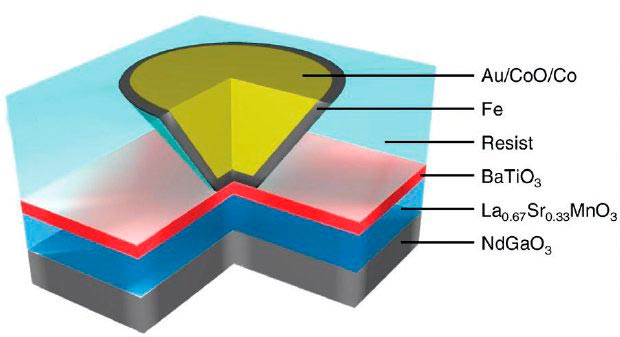
Physicists in France, Germany and the UK claim to be the first to control the polarization of a spin current by applying an electric field across an insulator. The technique requires much less energy than previous schemes for flipping spin, and could play an important role in the development of spintronics technology and ultimately smaller and more efficient electronic devices.
Spintronics is a relatively new area of research that exploits the spin of an electron as well as its charge. The spin can either be “up” or “down”, and this property could be used to store and process information in spintronic devices. Such circuits could be smaller and more efficient than conventional electronic circuits – which rely on switching charge – because switching spins from up to down could be done using very little energy, at least in principle.
For such devices to be practical, however, physicists need to work out a way to flip spins by applying electric fields, rather than magnetic fields. This is because magnetic fields are much more costly in terms of space and energy. Physicists have had some success in controlling spin by driving large currents through a magnetic conductor, but this is also very energy intensive.
Now, a team led by Agnès Barthélemy of CNRS/Thales Research and Technology and Université Paris-Sud in France has demonstrated electric-only control in a hybrid material made by coupling a ferroelectric to a ferromagnet. A ferroelectric is a material that contains tiny domains of electrical polarization, analogous to magnetic domains in a ferromagnet. This new result is exciting because it demonstrates a new type of magnetoelectric coupling, different to that which exists in the widely known composite materials, says team member Manuel Bibes, also at CNRS/Thales.
Tunnel magnetoresistance
The researchers began by making tiny tunnel junctions that combine two ferromagnetic electrodes – iron and the ferromagnetic oxide LSMO – separated by a layer of ferroelectric barium titanium oxide (BaTiO3) just 1 nm thick. Six months ago, the same team showed that such ferroelectric tunnel barriers could produce giant electroresistance effects at room temperature (Nature 460 81). Now, Barthélemy and colleagues have measured the tunnel magnetoresistance (TMR) after orienting the ferroelectric polarization in the BaTiO3 tunnel barrier up or down by applying voltage pulses of around 1 V. TMR is a well known effect in which the tunnel resistance depends on the magnetic alignment of two ferromagnets.
The TMR was found to depend on the ferroelectric polarization, which, according to the researchers, indicates a change in the spin-polarization of the tunnel current. “To our knowledge, this is the first time that spin-polarization has been controlled by an electric field alone,” Bibes told physicsworld.com.
All spintronic effects, such as TMR and giant magnetoresistance, depend on the spin-polarization of the electrical current. Controlling the spin-polarization by electric fields in this way therefore potentially opens the way to controlling all spintronics devices by purely electric means.
Interplay at the interfaces
On a more fundamental level, the new work also emphasizes the interplay between ferroic materials at interfaces, explained Bibes. This could lead to a new generation of artificial materials that exploit giant interfacial phenomena. “More practically, the result could prove useful in reducing the write power in magnetic random access memories (MRAMs).”
The team, which includes scientists from the Laboratoire de Physique des Solides in Orsay, France, BESSY in Berlin, Germany, and the University of Cambridge in the UK, is now planning complementary experiments to further investigate the interface physics in the LSMO/BaTiO3/Fe samples. “In the longer term, we will probably extend our study to other interface systems,” added Bibes.
The work was published in Sciencexpress.



